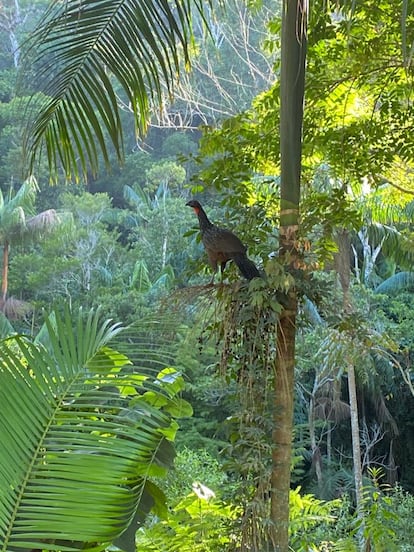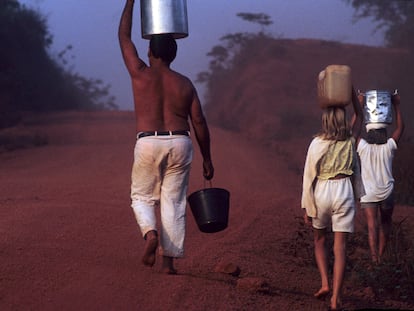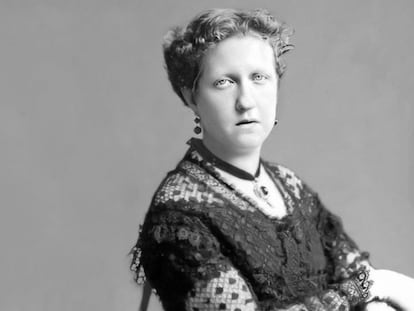‘Jacu’ coffee: Brazilian bird droppings secret ingredient in brew worth its weight in gold
Initially viewed as a plague, the arrival of the dusky-legged guan revolutionized a coffee plantation in Brazil. A kilo costs $1,700 at the Harrods department store in London
A coffee made from bird droppings that sells for the price of gold in Europe: this is the curious treasure that a Brazilian farm has been guarding for years, thanks to the surprise appearance of a bird similar to a pheasant. No one could have foreseen it, but the jacuaçu, or dusky-legged guan, with its discreet black plumage and powerful cries, possesses a digestive system that is a marvel. The coffee beans it leaves in its feces are like nuggets of gold. Nobody was more surprised about the chance discovery than Henrique Sloper, the owner of family-run coffee plantation who first defined the appearance of the birds as a “plague.” Little did he know that soon the animals would become his staunchest allies and a valued partner in the business.
“It was very scary. It’s a big bird, it makes a lot of noise, it breaks branches. There were a lot of them, so we called the environmental protection bodies, but they didn’t know what to do. They suggested we put in a predator. What were we going to put in? A jaguar? An eagle? In the end they just left me there with the birds,” Sloper recalls now with a chuckle during a telephone conversation with EL PAÍS. His land is scattered around a dozen valleys in the verdant mountains of Espírito Santo, in southeastern Brazil, next to a national park. If the state of Espírito Santo were a country, it would be the fourth-largest coffee producer in the world.

But among the thousands of coffee plantations in Brazil, this one stands out: it is the only one that has a bird as an ace up its sleeve. After the initial fright of the feathered invasion, Sloper recalls a trip to Indonesia, where he learned about the exclusive Kopi luwak coffee, which is made using the excrement of the palm civet, a small, nocturnal mammal. He decided to try his luck to copy the invention. At first, convincing the farm workers that they had to harvest jacuaçu droppings proved a challenge, but once they had overcome their qualms and following two years of trial and error, they came up with the formula.
Along the way they discovered several things, among them that the transit through the animal’s digestive tract means that these coffee beans do not need fermentation, and that the process eliminates almost all the caffeine. The beans come out in the birds’ feces perfectly whole. Also decisive was the good taste of the bird, which only eats the coffee beans when they are fully ripe. For the coffee to be considered of special origin on sales certificates the fruit must be harvested ripe, so the eating habits of the ‘jacu’ are a guarantee that the coffee will be of superior quality. After the peculiar harvest of excrement, the beans are dried, cleaned, and frozen for two to three months, ready for the process to begin when an order is placed. The coffee is so sought-after that it is only produced on demand. Its flavor is fruity and more acidic than other varieties.
The production of jacu coffee started over a decade ago and it quickly became one of the most expensive coffees in the world. It is sold in the exclusive Harrods department store in London at 1,400 pounds per kilo ($1,700). France and Japan, markets where there is considerable interest in exotic products, are also among the biggest importers, says Sloper. The interest arises not only from the eccentricity of drinking coffee that is produced from the feces of a bird, but also from the whole philosophy behind this farm.
Before the jacu made its stellar appearance, Sloper’s coffee plantation was already committed to organic agriculture and the agroforestry system, a sustainable alternative for the management of tropical forests that promotes coexistence with native vegetation. Here, there are no endless monoculture plantations; coffee plants are mixed with other trees and bushes, including bananas, pitangas, jabuticabas and red fruits of all kinds, which are used to make jams. The balanced biodiversity of the environment helps to prevent the appearance of fungi and creates a substrata of leaf litter that allows the coffee to grow more vigorously. If the average coffee production per hectare in Brazil is around 26-28 bags, in this type of plantation 35 are harvested, says Sloper, who has become a fervent advocate of the system. “Before, you were an agronomist and they taught you how to put poison in the soil. But there’s no going back now. The market demands are different; people don’t want to eat things with glyphosate and all that stuff we used for so long. It is a pressure that from the consumers themselves.”
Although Brazil is still dominated by huge monoculture estates dedicated to the export of commodities, agroforests are gradually gaining ground. The Alliance for the Restoration of the Amazon, for example, has identified more than 1,600 such initiatives in the Amazon region alone. The agroforestry system also serves as a buffer against extreme climatic phenomena, which are becoming increasingly frequent. Droughts, floods, and frosts can be weathered better when a range of flora and fauna are protecting each other.
In this habitat that it has made his own, the jacu, in addition to harvesting coffee, also has other functions, as Sloper points out: “It reforests the jungle, because it is a great disseminator of seeds. There is coffee growing in the middle of the forest,” he says, adding that coexistence with the bird is very respectful. It is always kept free range, contrary to the Indonesian civet coffee, which has come under increasing scrutiny as the animals in kept in cages, and the location of its nests is controlled so as not to damage them during the harvesting of other varieties of coffee produced on the farm. What started as Hitchcockian scare has blossomed into an alliance between man and nature that appears to have a promising future ahead of it. “It’s not a bird that eats and leaves. It stays here. There are already several generations that have been born on this land,” says Sloper.
Sign up for our weekly newsletter to get more English-language news coverage from EL PAÍS USA Edition
Tu suscripción se está usando en otro dispositivo
¿Quieres añadir otro usuario a tu suscripción?
Si continúas leyendo en este dispositivo, no se podrá leer en el otro.
FlechaTu suscripción se está usando en otro dispositivo y solo puedes acceder a EL PAÍS desde un dispositivo a la vez.
Si quieres compartir tu cuenta, cambia tu suscripción a la modalidad Premium, así podrás añadir otro usuario. Cada uno accederá con su propia cuenta de email, lo que os permitirá personalizar vuestra experiencia en EL PAÍS.
¿Tienes una suscripción de empresa? Accede aquí para contratar más cuentas.
En el caso de no saber quién está usando tu cuenta, te recomendamos cambiar tu contraseña aquí.
Si decides continuar compartiendo tu cuenta, este mensaje se mostrará en tu dispositivo y en el de la otra persona que está usando tu cuenta de forma indefinida, afectando a tu experiencia de lectura. Puedes consultar aquí los términos y condiciones de la suscripción digital.
More information

Brazil develops the first vaccine against schistosomiasis, the disease of swollen bellies
Archived In
Últimas noticias
Most viewed
- David King, chemist: ‘There are scientists studying how to cool the planet; nobody should stop these experiments from happening’
- Reinhard Genzel, Nobel laureate in physics: ‘One-minute videos will never give you the truth’
- Mexico completes its trade shift with the entry into force of tariffs on China and countries without trade agreements
- Oona Chaplin: ‘I told James Cameron that I was living in a treehouse and starting a permaculture project with a friend’
- Sinaloa Cartel war is taking its toll on Los Chapitos









































